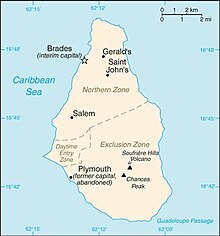

The following outline is provided as an overview of and topical guide to Montserrat:
Montserrat – British overseas territory located in the Leeward Islands of the Lesser Antilles archipelago in the Caribbean Sea.[1] The Island of Montserrat is approximately 16 km (9.9 mi) long and 11 km (6.8 mi) wide with 40 kilometres (25 mi) of coastline. The island was given its name by Christopher Columbus on his second voyage to the New World in 1493, after its namesake located in Catalonia. Montserrat is often referred to as the Emerald Isle of the Caribbean, due both to its resemblance to coastal Ireland and to the Irish descent of most of its early European settlers.
Its Georgian era capital city of Plymouth was destroyed and two-thirds of the island's population forced to flee abroad by an eruption of the previously dormant Soufriere Hills volcano that began on July 18, 1995.[2] The eruption continues today on a much reduced scale, the damage being confined to the areas around Plymouth including its docking facilities and the former W.H. Bramble Airport. An exclusion zone extending from the south coast of the island north to parts of the Belham Valley has been closed because of an increase in the size of the existing volcanic dome. This zone includes St. George's Hill which provided visitors with a view of the volcano and the destruction it has wrought upon the capital. A new airport at Gerald's in the northern part of the island opened in 2005. The village of Brades currently serves as the de facto centre of government.
- ^ "Montserrat". The World Factbook. United States Central Intelligence Agency. 6 July 2009. Retrieved 23 July 2009.
- ^ Montserrat Volcano Observatory Archived 2006-10-02 at the Wayback Machine Retrieved 2 October 2006.


